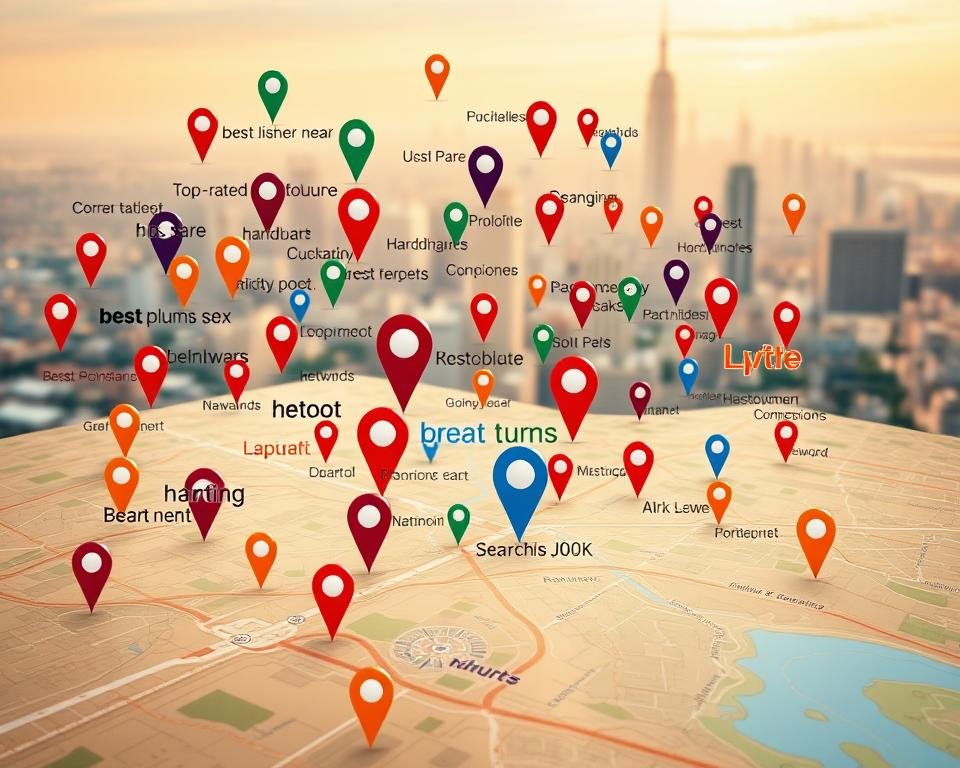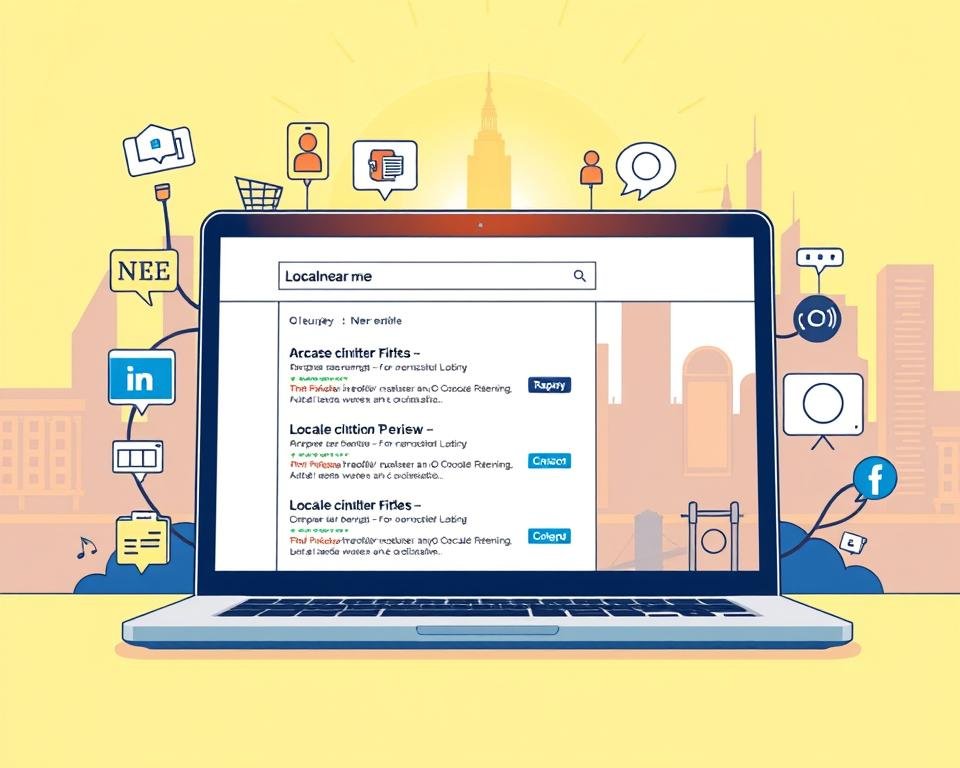As a business owner, you know how key it is to be seen online. This is even more true when people are looking for things near you. Local SEO optimization is key to getting more eyes on your business.
I’ll show you how to make your site better for “near me” searches. You’ll get tips and strategies to boost your local search rankings. Using geo-targeted keywords can help your site get more visitors.
Key Takeaways
- Understand the importance of local SEO optimization
- Learn how to use geo-targeted keywords effectively
- Improve your website’s visibility for “near me” searches
- Drive more traffic to your business with local SEO strategies
- Enhance your online presence with optimized local search rankings
Understanding “Near Me” Searches
Smartphones have made “near me” searches very important. As a business owner, knowing about these searches is key. It helps attract local customers and stay ahead.
What Are “Near Me” Searches?
“Near me” searches are when people look for businesses near them. They usually do this on mobile devices. The results show places close to where they are, making it more personal.
For example, someone might search for “coffee shops near me” or “restaurants near my location.” The search engine shows a list of nearby businesses. This makes it easy for people to find what they need.
Importance of “Near Me” Searches for Businesses
“Near me” searches are very important for businesses. They help bring in more customers and sales. By focusing on these searches, businesses can get more people to visit and buy from them.
Key benefits of optimizing for “near me” searches include:
- Increased visibility in local search results
- Improved foot traffic and sales
- Enhanced customer engagement through proximity marketing tactics
- Better competitiveness in the local market
By understanding and using “near me” searches, businesses can create better strategies. These strategies help reach their audience and succeed in the long run.
The Rise of Local Search
Mobile devices are now a big part of our lives. This has made local search very important. Businesses need to change how they work online to keep up with local search trends.
Trends in Local Search Behavior
There are a few big trends in local search. More people are using voice search to find local places. They also want quick results when looking for local businesses.
Mobile search optimization is key in these trends. It helps businesses show up in local search results. Making sure your business is easy to find on mobile devices is now a must.
Statistics Supporting Local Searches
Local search is very important, as shown by some stats. A lot of people use their phones to find local businesses. Many of these searches lead to a purchase or a visit.
| Statistic | Percentage | Implication |
|---|---|---|
| Consumers using mobile devices for local searches | 76% | High demand for mobile-friendly local business listings |
| Local searches leading to store visits | 50% | Significant foot traffic driven by local search |
| Local searches resulting in purchases | 28% | Substantial conversion rates from local search |
These stats show how important local business listings are. By focusing on local search, businesses can get more visibility and attract more customers.
Keyword Research for Local SEO
Knowing the right keywords is key for your local business online. Good keyword research finds the terms your customers use to find you. This helps you show up in local searches.
Tools for Keyword Research
Many tools help with local SEO keyword research. Some top ones are:
- Google Keyword Planner: Finds keywords and shows how often they’re searched.
- Ahrefs: Does deep keyword research and checks out your competitors.
- SEMrush: Helps with keyword plans and checks what your competitors use.
These tools help you find geo-targeted keywords with your location. This draws in local searchers.

Identifying Local Keywords and Phrases
To find local keywords, try these tips:
- Put your city, state, or region in your keywords.
- Use keywords about local landmarks or areas.
- Choose industry-specific terms that fit your local market.
| Keyword Type | Example | Relevance |
|---|---|---|
| Location-based | “New York coffee shop” | High |
| Industry-specific | “Dental clinic California” | High |
| Service-based | “Emergency plumbing service NYC” | Very High |
Analyzing Competitor Keywords
Looking at your competitors’ keywords can teach you a lot. Find top competitors and check their sites to see:
- The keywords they use.
- The content they make with those keywords.
- How they use customer reviews and ratings in their SEO.
Knowing what works for them helps you improve your own strategy. This way, you can outdo your competitors online.
Claim and Optimize Your Google My Business Listing
Google My Business is a great tool for local businesses. It can make your business more visible in local searches. Claiming and optimizing your listing can help you rank better in local searches and draw in more customers.
Steps to Claim Your Listing
To begin, claim your Google My Business listing. You need to verify your business location and make sure your listing is correct and current.
- Go to the Google My Business website and sign in with your Google account.
- Enter your business name and location to find your listing.
- Follow the prompts to verify your business, which may involve receiving a postcard or phone call from Google.
Tips for Optimization
After claiming your listing, optimize it. Add good photos, reply to customer reviews, and make sure your hours are right.
Use high-quality imagesthat show your business, like your storefront, products, and services. This helps customers understand what you offer.

Encouraging Customer Reviews
Customer reviews are key for local SEO. Encourage reviews by providing great service and making it easy for customers to share their thoughts.
- Ask happy customers to leave a review on your Google My Business listing.
- Reply quickly to all reviews, good or bad, to show you value feedback.
- Use review insights to improve your business.
By following these steps and tips, you can make your Google My Business listing better. This will help you show up more in local searches and bring in more customers.
On-Page SEO Tactics for Local Optimization
Good local SEO starts with making your website better for local searches. On-page SEO makes your site rank higher in local searches. It’s key for local SEO.
Crafting Localized Content
Creating content for your local audience is vital. Use local keywords in your content. This keeps it interesting and useful.
For example, if you’re in New York, use “New York” or “NYC” in your content. Key strategies include writing about local events and news. This boosts your local search rankings and connects with your customers.
Optimizing Meta Tags for Location
Meta tags, like title tags and meta descriptions, are important for local SEO. Adding location-based keywords to these tags can make your site more visible in local searches.
- Make sure your title tags have your main location-based keyword.
- Write meta descriptions that include your location and make people want to visit your site.
Localizing Images and Alt Text
Optimize your website’s images for local SEO by using location-based keywords in alt text and file names. This helps search engines understand your images better. It can also improve your image search results.

For instance, name a storefront picture “storefront-new-york.jpg”. Use alt text like “storefront in New York”. This is helpful.
Creating Local Content
Creating local content helps make your business a local leader. A good content strategy for local SEO can draw in local visitors. This boosts your search rankings.
Blog Topics That Attract Local Traffic
It’s key to make blog topics that speak to your local audience. Some great ideas include:
- Local news and events
- Community spotlights
- Local guides and resources
- Industry insights specific to your local area
By making content that matters to locals, you can get more engagement and attract local customers.

Utilizing Local News and Events
Using local news and events is smart for timely content. It shows your business cares about the community. This draws in local visitors.
Here are some ways to use local news and events:
- Write news articles or blog posts about local events
- Join local events and support local causes
- Use social media to share local news and events
Case Studies and Success Stories
Sharing success stories and case studies proves your business’s worth. It shows you’re good at what you do. This builds trust with locals.
Here’s how to make great case studies:
- Focus on local customers’ challenges and wins
- Use numbers and facts to show your impact
- Show how your products or services help locals
By using smart marketing and optimizing your listings, you can get more local customers. This boosts your local content.
Building Local Citations
To boost your local search rankings, focus on building quality local citations. These are mentions of your business in online directories. They are key for local SEO optimization. By listing your business in many directories, you can get more visibility and attract customers.
Importance of NAP Consistency
NAP consistency means your business’s Name, Address, and Phone number are the same everywhere. It’s vital because it makes search engines trust your info. If your NAP is not the same, it can confuse people and hurt your rankings.
To keep NAP consistent, I suggest:
- Use the same format for your business name everywhere.
- Keep your address and phone number current.
- Check your citations often to fix any mistakes.
Key Directories to Consider
There are many online directories where you can list your business. Some top ones are:
- Google My Business
- Yelp
- Bing Places
- Apple Maps

Monitoring Your Citations
It’s important to watch your citations for accuracy and consistency. Tools like Ahrefs or Moz can help track them. Also, keep an eye on customer reviews and ratings, which are key for local SEO.
By creating and keeping up quality local citations, you can boost your local search rankings. Remember, customer reviews and ratings are important for local SEO. So, ask your customers to leave reviews on your listings.
Leveraging Social Media for Local Exposure
Local businesses can get more visible and engage with customers by using social media. It has tools and features to help reach more people. This can also improve their local SEO.
Best Social Platforms for Local Businesses
Choosing the right social media platforms is key for local businesses. Facebook is great because it has over 2.7 billion users. Instagram and Twitter are good for businesses with nice visuals.

Engaging with Local Customers
It’s important to talk to local customers on social media. Quick responses build trust and satisfaction. Sharing local news and events can also make customers feel part of a community.
- Respond to customer inquiries and comments promptly
- Share local news and events to create a sense of community
- Use social media to promote local products and services
Running Local Promotions on Social Media
Local promotions on social media can boost sales and engagement. Businesses can share special offers and deals. This targets people nearby, making them more likely to buy.
To make promotions work, create engaging content. Use nice visuals, write catchy captions, and use hashtags.
Mobile Optimization for Local Searches
Mobile optimization is key for local SEO success. More people use smartphones for ‘near me’ searches. Having a mobile-friendly website is vital for attracting and keeping customers.
Importance of Mobile-Friendly Websites
A mobile-friendly website is essential for a good user experience. It loads fast, is easy to navigate, and looks good on small screens. This makes users happy and helps your site rank better in search results.
Key benefits of mobile-friendly websites include:
- Improved user experience
- Faster page loading speeds
- Enhanced search engine rankings
- Increased conversions and sales
Best Practices for Mobile Optimization
To optimize your website for mobile, follow some best practices. Make sure your site is responsive, optimize images and content for speed, and ensure easy navigation on mobile devices.
| Best Practice | Description | Benefit |
|---|---|---|
| Responsive Design | A design that adapts to different screen sizes | Improved user experience across devices |
| Image Optimization | Optimizing images to reduce file size | Faster page loading speeds |
| Simplified Navigation | Easy-to-use navigation on mobile devices | Increased user engagement and conversions |

By following these best practices, businesses can boost their mobile search optimization. This makes it easier for local customers to find and engage with them online.
Tracking and Analyzing Your Local SEO Efforts
To make your local SEO better, you need to check your progress often. This helps you see what’s working and what’s not. Then, you can change your plan to get higher in local search results.
Monitoring Performance with the Right Tools
I use Google Analytics and Google Search Console to keep an eye on my local search. These tools show me how many people visit my site, how they interact, and if they buy anything. They help me make my local SEO better. Using the right keywords for your area is key to being seen more in local searches.
Key Performance Indicators for Local SEO
I watch my website’s traffic, how well I rank in search engines, and how people interact with my site. Looking at these numbers helps me see patterns. This way, I can make smart choices to boost my local SEO.
Adjusting Your Strategy Based on Data
Looking at my local SEO data helps me fine-tune my approach. I tweak my keywords, make my Google My Business listing better, and create content that’s more local. This way, I can get more people to visit my site from my area.
